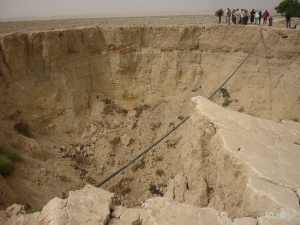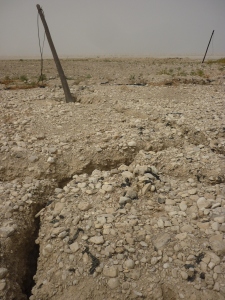In the past few decades sinkholes have permeated the area around the Dead Sea. The eruption of these large cavities has undeniably become a serious issue of human and environmental safety which is also tied to the fight to stop the Dead Sea’s shrinkage.

Dead Sea sinkholes are created with a sudden collapse of earth due to geologic instability. They vary in size, with some measuring up to 25 meters or more in width and over 20 meters deep. The sinkholes are divided into three types: gravel holes occurring in alluvial fans, mud holes occurring in clay deposits, and a combination of the two. Gravel holes are funnel shaped and can be 1-30m in diameter, and mud holes are around 3-20m in diameter.

The sinkholes began appearing south of Ein Gedi in the 1970s. In the 1990s the ecological phenomenon spread north of Ein Gedi while continuing to the south. Their existence has remained largely restricted to the western border of the Dead Sea, where there are estimated to be around 1,500 sinkholes currently. They occur in a narrow strip 60km long and 1km wide, and spread roughly parallel to the fault system associated with the Dead Sea Transform rift valley, a geological depression. In the past few years the rate of sinkhole formation has greatly accelerated to around 150-200 new sinkholes a year.
The cause of this environmental catastrophe is linked strongly to the decline in the level of the Dead Sea. This decrease is caused by the diversion of an estimated 98% of the Lower Jordan River’s flow to the Dead Sea for agricultural, industrial, and household needs of surrounding countries combined with the inefficient mineral harvesting methods employed by the Dead Sea mineral companies in Israel and Jordan. From the 1930s to 1999 the level declined by over 25 meters, with the rate of decrease accelerating significantly to about 1m a year since the mid 1970s.

The decrease in the water level has caused a dissolution of the 10,000-year-old subsurface salt layer by fresh groundwater, and a migration eastward of the fresh-saline water interface. This ecological destabilization can cause sinkholes that develop within a matter of days. This makes the sinkholes difficult to predict and difficult to prevent.
There is no question that these sinkholes are a dramatic danger to human life and development in the region. In order to stop their quickening spread, efforts to restore the Lower Jordan River’s fresh water flow to the Dead Sea must be supported, as well as continued research to understand why they happen, how to prevent them, and where to go from here.
This post was written by FoEME intern Briana Parker. Briana is based in FoEME’s Amman office.